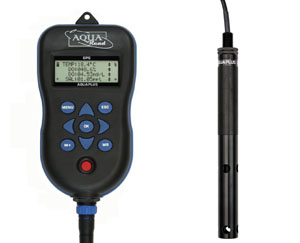Bell Environmental understand that ensuring good water quality is essential when reviewing the Aquaculture Industry. It determines the health, quality and growth of aquatic wildlife and management will look to monitor some key water quality parameters to ensure these valuable assets are of the best quality. The key parameters of interest are dissolved oxygen, pH, temperature, conductivity, ammonia and nitrates.
Correct monitoring of these will allow an Aquaculture business to be sustainable, with the benefit of being compliant with both industry and government regulations. By using water quality instrumentation, management will be able to keep a close eye on the water quality, its relation to feeding habits and therefore optimum growth conditions.
What solutions are available at Bell Environmental?
-
Digisens water quality probes
Our Aqualabo Digisens water quality probes can provide readings for pH, Conductivity, Dissolved Oxygen and Turbidity. All our sensors use a Modbus protocol which means the sensor can be integrated directly into a local PLC / control system that can accept this form of communication.
-
Point Colour remote data collection
Our remote data systems allow you to collect data from directly from the sensors, without the need for a display. Data from the sensors can be provided to a web based platform via GSM/GPRS.
-
Ethernet Data Collection
Our Ethernet based data collection systems provide data directly from your sensors in the field to a web based portal. These units are typically mains powered and provide a good solution if wireless connectivity is not required.
-
Test Kits for Aquatic Farming / Fish Farming.
-
Odeon Photopod
The Photopod simply connects onto our Ponsel Odeon handheld water quality meter and allows for the measurement of over 50 additional parameters such as ammonia and nitrates.
-
S200 stationary display
The S200 stationary display provides a local readout for all of our Ponsel Digisens sensors. The device also allows for calibration and provides external outputs for integration into a local data management system or telemetry device.
-
Module 4001
If utilising more than one Digisens sensor, the Module 4001 can be used to connect up to 5 sensors, providing a central location where power can be provided and calibration undertaken.
-
Spectrophotometer for laboratory water quality analysis.
What are the advantages of these systems?
Remote Data Recording
Our remote data logging systems ensure that you can receive and view data wherever a web browser is available, whether this is on a PC, tablet or smart phone. These systems provide you with a remote view of the water quality conditions and mean you can monitor and be reactive to sudden changes. Our systems also allow for the configuration of alarms either via SMS or email. This can mean if a particular condition is met by one of the sensors then an email or SMS would be sent to a pre-defined mobile number or email address, for example an alarm can be set on the device if the pH exceeds 9.
Smart Sensors
All of Bell Environmental’s Digisens sensors utilise on-board smart processing, and can work with both our handheld Odeon device and our S200 displays. The sensors can also work as a standalone product allowing for integration into third party systems and data loggers. This means that the systems can save you money, as you can either look to utilise existing equipment or you can reduce the number of instruments required. As an example if you had a third party compatible data control system on site, and were looking to monitor pH and dissolved oxygen, a traditional system would require you to have a sensor and a display at each location. With the Digisens range you can simply connect the sensors directly to the control system, saving you money.
Real Values in Real Time
Bell Environmental’s Digisens sensors will provide quick / responsive readings, which are highly accurate and reliable, to ensure your process is performing correctly. The sensors can also be calibrated locally using the Odeon display, or using the local S200 display. Procedures for this are simple to follow and allow systems to be calibrated and returned back to operation quickly.

For further information on our Ponsel and Aqualabo monitoring systems please call us on 01280 817304 or e-mail our sales team directly at mail@bellenviro.co.uk.
Please visit our website https://www.bellenviro.co.uk/water-quality-monitoring/ for more information.




